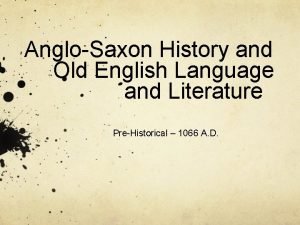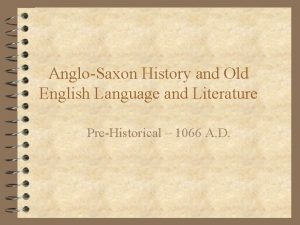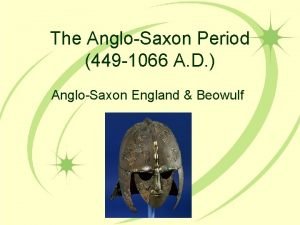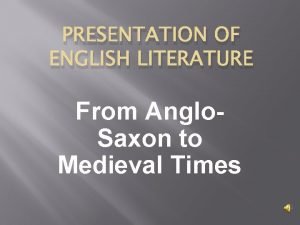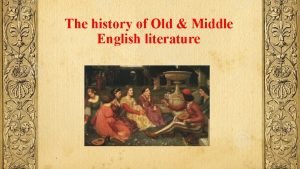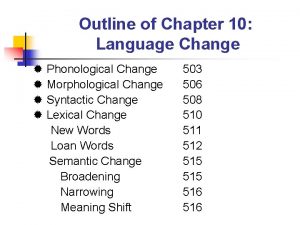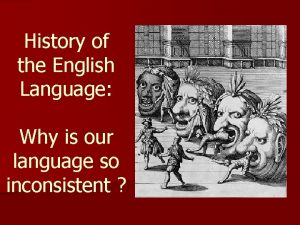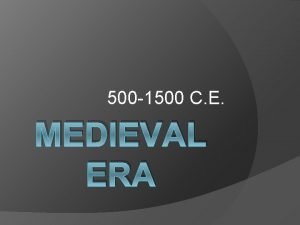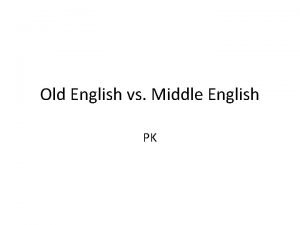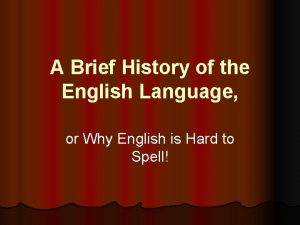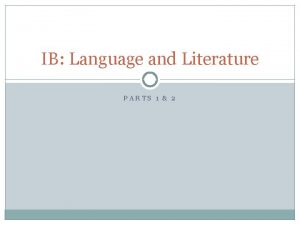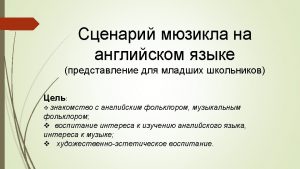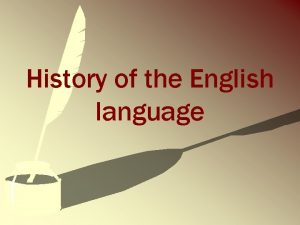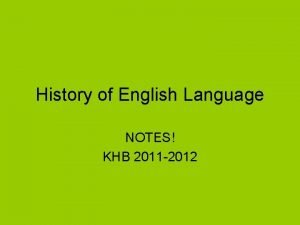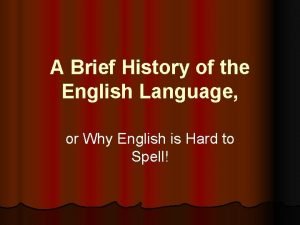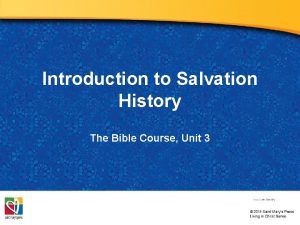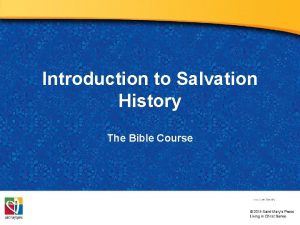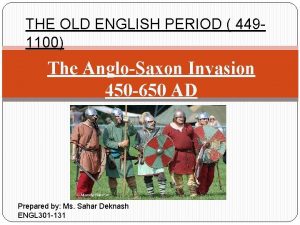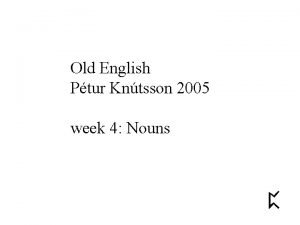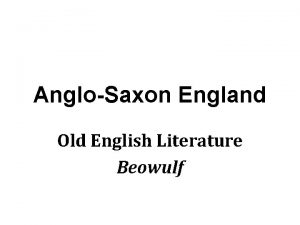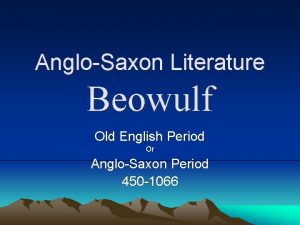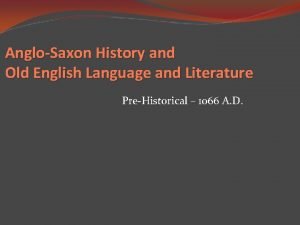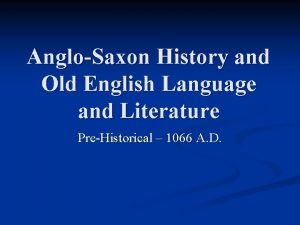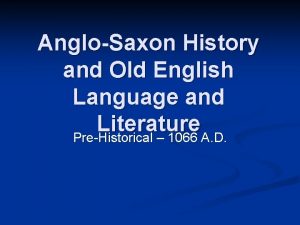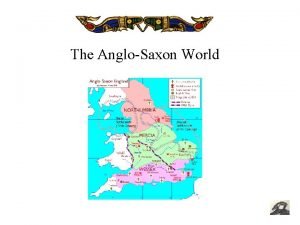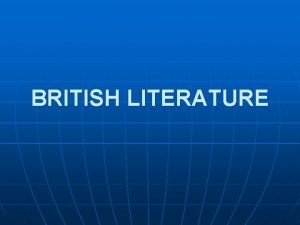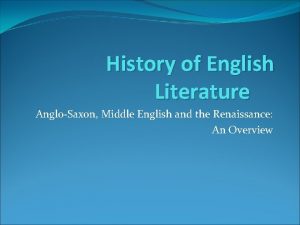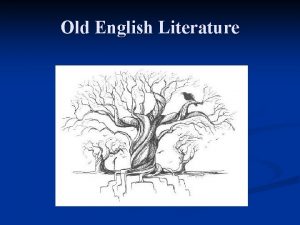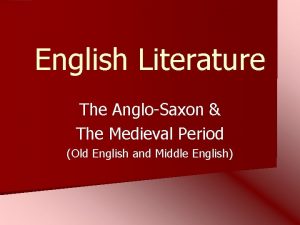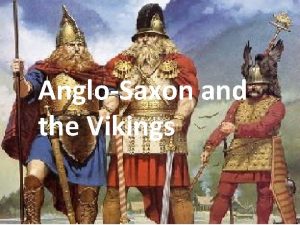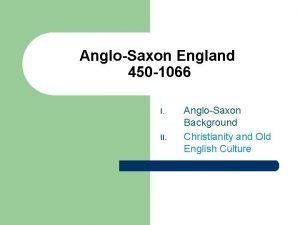AngloSaxon History and Old English Language and Literature






























- Slides: 30

Anglo-Saxon History and Old English Language and Literature Pre-Historical – 1066 A. D.

Great Britain and Ireland

Overview of Periods of Early English History Pre-History— 1066 A. D. 1. Pre-Roman/Pre-Historical up to 55 B. C. 2. Roman Occupation 55 B. C. – 410 A. D. 3. Anglo-Saxon Period 410 – 787 A. D. 4. Viking Invasions 787 – 1066 A. D. 5. Norman Conquest begins in 1066

Pre-Historical / Pre -Roman

What is Stonehenge? Stonehenge is a ring of gigantic stones (known as sarsens and “blue stones”) that stand up to 30 high and weigh up to 25 tons. It sits on a plain north of Salisbury, England its construction and history are shrouded in mystery. No one is sure why or even how this monument was created. However we do know it is over 5, 000 years old, even older than the great pyramids of Egypt. Stonehenge is one of the most iconic symbols of ancient Britain. It is a legendary symbol that represents the ancient history of this island. Most historians today believe it was built by Druids long ago to be possibly a center for healing, a temple, a point of union for Britain, or a sacred burial ground. And, of course, aliens could have come down and built it for mysterious reasons!

Pre-Historical / Pre-Roman The island we know as England was occupied by a race of people called the Celts. One of the tribes was called they Brythons or Britons (where we get the term Britain) The Celts were Pagans and their religion was know as “animism” a Latin word for “spirit. ” Celts saw spirits everywhere Druids were their priests; their role was to go between the gods and the people

Roman Occupation Hadrian’s Wall

Important Events During Roman Occupation Julius Caesar begins invasion/occupation in 55 B. C. Occupation completed by Claudius in 1 st cent. A. D. Hadrian’s Wall built about 122 A. D. Romans “leave” in 410 A. D. because Visigoths attack Rome St. Augustine (the “other” St. Augustine!) lands in Kent in 597 and converts King Aethelbert (king of Kent, the oldest Saxon settlement) to Christianity; becomes first Archbishop of Canterbury

Boudicca Queen of the Iceni Boudicca was the wife of King Prasutagus of the Iceni, a British Celtic tribe that lived in what is now East Anglia. When Prasutagus died, he left his kingdom jointly to both his two daughters and the Roman Emperor. However, his wishes were ignored by the Romans, and the Roman army marched in and took over the place, taking time out to flog Boudicca and rape her daughters. But a woman like Boudicca does not let such actions go unpunished. She led the Iceni and several other tribes in a bloody revolt, burning Colchester, London and St. Albans to the ground. Unfortunately, the Roman war machine eventually triumphed, and Boudicca was defeated at the Battle of Watling Street. She poisoned herself and her daughters to spare them a humiliating, painful death in the Roman arena, as was Roman custom with prisoners of war. Despite her defeat, she is remembered and honored for putting

Important Cultural and Historical Results of the Roman Occupation Military—strong armed forces (“legions”) Pushed Celts into Wales and Ireland Prevented Vikings from raiding for several hundred years: C. Warren Hollister writes, “Rome’s greatest gift to Britain was peace” (15). Infrastructure Government (fell apart when they left) Walls, villas, public baths (some remains still exist) Language and Writing Latin was official language Practice of recording history led to earliest English “literature” being documentary Religion Christianity beginning to take hold, especially after St. Augustine converts King Aethelbert

The Most Important Results of the Roman Occupation Latin heavily influenced the English language Relative Peace Christianity begins to take hold in England (but does not fully displace Paganism for several hundred years)

The Anglo-Saxon Period 410 -787

Important Events in the (First) Anglo-Saxon Period 410 - 450 Angles and Saxons invade from Baltic shores of Germany, and the Jutes invade from the Jutland peninsula in Denmark The Geats are a tribe from Jutland Nine Anglo-Saxon Kingdoms eventually became the Anglo-Saxon heptarchy (England not unified), or “Seven Sovereign Kingdoms”

Anglo-Saxon Heptarchy = Seven Kingdoms 1. Kent 2. Essex (East Saxon) 3. Sussex (South Saxon) 4. East Anglia 5. Northumbria 6. Mercia 7. Wessex (West

Viking Invasions 787 -1066

Vikings By definition, Vikings were sea-faring (explorers, traders, and warriors) Scandinavians during the 8 th through 11 th centuries. Oddly enough, the Anglo-Saxon (and Jute) heritage was not much different from the Vikings’: they, too, were Scandinavian invaders. In fact, some Vikings were also called “Northmen” which is related to yet another culture (this one French) which made conquest of England—the Normans, and William the Conqueror in 1066. However, when the Viking raids began around 787, the Anglo-Saxons were different culturally from the Viking invaders

They were ALL Vikings! Except for the Celts* and the Romans, all of the cultures who successfully invaded England in the first millennium were from Northern Europe at one time or another. The Angles, Saxons, Frisians, and Jutes were from the Baltic region, and the Normans (1066) were primarily from Normandy and had originally been from Norway *the Celts were indigenous at the time of the Roman conquest, and are therefore considered England’s “natives”

Important Results of the Viking Invasions Politically and Culturally Continued political instability and conflict (i. e. , tribal war): there was no central government or church* The Anglo-Saxon code (more on this when we read Beowulf) Linguistically (The English Language at its Earliest) The English language is “born” during the first millennium and is known as Old English (OE). Anglo-Saxon is the term for the culture. Old English is mainly Germanic** in grammar (syntax and morphology) and lexicon (words) the core of our modern English is vastly influenced by this early linguistic “DNA” (but even Germanic languages derived from a theoretical Proto-Indo. European language, the grandparent of classical languages such as Greek, Sanskrit, Latin, and German (**Remember: Vikings were Germanic people) LOTS of dialects of Old-English, as one might imagine. This is because there were several separate Kingdoms many founded by essentially five or six different cultures: Angles, Saxons, Frisians, Jutes, Danes, and Swedes *Alfred the Great (ruled from approx. 871 -899 A. D. ) was one of the first Anglo-Saxon kings to push Vikings back; in fact, he was one of the first kings to begin consolidating power, unifying several of the separate Anglo-Saxon kingdoms

Huh? (we better boil those important results down!) Lots of ongoing tribal feuds and wars led to. . . Lots of intermingling of similar but different Germanic languages. . . interrupted by. . . MORE Viking invasions, which gave way to. . . Some political unification (Alfred). . . Which led to. . . OLD ENGLISH, the earliest form of our language!!

Early England Created by Three Invasions 1. Roman Occupation 55 B. C. -410 A. D. 2. Anglo-Saxon and Viking Invasions 410 – 1066 A. D. GERMAN(IC) LATIN 3. The Norman Invasion (The Battle of Hastings) in 1066 A. D. FRENCH

Norman Invasion In 1066 at the Battle of Hastings, the Normans (powerful Northern Frenchmen) defeated the English and started a centuries-long conquest of England Two Most Important Effects: French becomes official language of politics and power and exerts enormous influence on Old English England begins unifying under a French political system, much of which is still with us (even in the U. S. ) today

The Anglo-Saxon Period in Review Pre-Anglo-Saxon (really “pre” historical) Celtic Peoples (approx 1700/400 B. C. – 55 B. C. ) Roman Occupation (55 B. C. -410 A. D. ) Anglo-Saxon/Viking Angles, Saxons, Frisian, and Jutes (410787 Viking Raids/Invasions begin 8 th c. and end 10 th c. Norman Invasion/Occupation (really in the Middle Ages) Battle of Hastings in 1066, then about four centuries of French rule

A Short History of Our Language —or— “How English got to be so hard to study, but is still so beautiful to hear and read”

Quick History of English Language Old English (OE) dates from approximately* 400 A. D. to 1066 Middle English (ME) dates from approximately 10661485 They are quite different to the eye and ear. Old English is nearly impossible to read or understand without studying it much like and English speaker today would study French, Latin, or Chinese *The dating of the beginnings of OE is difficult; scholars only have written texts in OE beginning in around 700 A. D. , but peoples in England must have been speaking a version of OE prior to works being written in the vernacular (as opposed to Latin)

Another Way of Looking at the History of English Old English 400 -1066 Beowulf (from Beowulf!) “Gaæþ a wyrd swa hio scel” (OE) = “Fate goes ever as it must” (Mn. E) Middle English 10661485 Chaucer (from CT) “Whan that Aprille with his shoures soote. . . ” (ME) = “When that April with its sweet showers. . . ” (Mn. E) Early Modern English 14851800 Shakespe are (from KL) “Sir, I loue you more than words can weild ye matter” (EMn. E) = “Sir, I love you more than word can wield the matter” (Mn. E) It is a truth universally Modern 1800 Austen OE=Old English ME=Middle English EMn. E=Early Modern English Mn. E=Modern English present (from P&P) acknowledged, that a single man (from P&P)

English = ? Celtic (from 1700 or 400 B. C. to 55 B. C. ) + Latin (from 55 B. C. to 410 A. D. ) + German (from 410 A. D. to 1066 A. D. ) + French (from 1066 A. D. to 1485 A. D. ) = OLD ENGLISH and MIDDLE ENGLISH VERY DIFFICULT LANGUAGE, BUT ONE PERFECT FOR LIMITLESS AND BEAUTIFUL EXPRESSION

English is a Melting Pot of Indo. European Languages Celtic Latin German French

Transition to Beowulf The major text we will read from this period is the epic Beowulf. It is the story of a Scandinavian (Geat) “thane” (warrior or knight) who comes to help a neighboring tribe, the Danes, who are being attacked by a monster. We study English history to understand the context of Beowulf, and we study Beowulf to understand the world which was Old England. According to Venerable Bede (an early English historian who lived in the eighth century), the Britons called the Romans for help when the Picts and Scots were attacking them (B. C. ). Hundreds of years later, the Britons called the Saxons to help them when the Romans couldn’t. The Saxons came “from parts beyond the sea” (qtd. in Pyles and Algeo 96). This journey of Germanic peoples to England “from parts beyond the sea” is the prototypical story for the first millennium of England’s history. It formulates much of their cultural mindset and clearly influences their stories. Be sure to consider how it plays a role in

Bibliography Abrams, M. H. , and Stephen Greenblatt, Eds. Introduction. The Norton Anthology of English Literature, seventh ed. , vol. 1. New York: W. W. Norton, 2000. 1 -22, 29 -32. Anderson, Robert, et al. Eds. Elements of Literature, Sixth Course, Literature of Britain. Austin: Holt, Rinehart and Winston, 1993. 2 -42. Burrow, J. A. “Old and Middle English Literature, c. 700 -1485. ” The Oxford Illustrated History of English Literature. Ed. Pat Rogers. Oxford: Oxford UP, 1987. Grant, Neil. Kings and Queens. Glasgow: Harper Collins, 1999. Hollister, C. Warren. The Making of England, 55 B. C. to 1399. 6 th ed. Lexington, Mass. : D. C. Heath, 1988 Pyles, Thomas and John Algeo. The Origins and Development of the English Language. 4 th Ed. Fort Worth: Harcourt, 1993. Wikipedia (articles on “Norman Invasion, ” “Roman Occupation of Britain, ” “King Alfred, ” “King Aethelbert, ” “Vikings, ” and “Battle of Hastings”). Dates of access: August 10 -20, 2006.

 Anglosaxon history
Anglosaxon history Old english kingdoms
Old english kingdoms Anglo saxon runes alphabet
Anglo saxon runes alphabet Feudal system definition
Feudal system definition Anglo saxon characteristics
Anglo saxon characteristics Old english period
Old english period Semantic change
Semantic change Old english vs modern english
Old english vs modern english Old english vs modern english
Old english vs modern english Olde english examples
Olde english examples History of english summary
History of english summary What is romantic age in literature
What is romantic age in literature Who is father of english drama
Who is father of english drama Eduqas english language a level
Eduqas english language a level Language english
Language english Wjec a level english language and literature
Wjec a level english language and literature Wjec english language a level
Wjec english language a level Ib english language and literature part 3
Ib english language and literature part 3 Edexcel igcse english literature paper 2
Edexcel igcse english literature paper 2 Once upon a time there was a little girl
Once upon a time there was a little girl Once upon a time there lived an old man and an old woman
Once upon a time there lived an old man and an old woman Shoen family tree
Shoen family tree History of english language timeline
History of english language timeline Brief history of english language
Brief history of english language How old are you what's your name
How old are you what's your name Once upon a time there lived an old woman
Once upon a time there lived an old woman A level english language language change
A level english language language change What are the two pillars of divine revelation
What are the two pillars of divine revelation Salvation history examples
Salvation history examples Old english kingdoms map
Old english kingdoms map Old english nouns
Old english nouns
